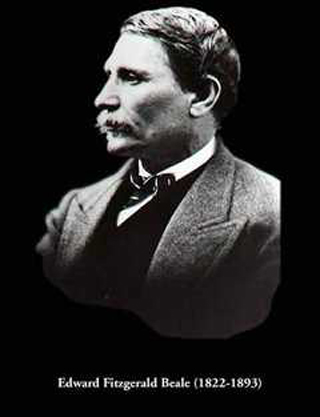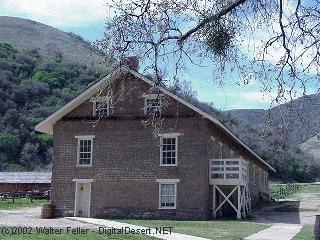Overview of Fort Tejon
(Camp Canada de las Uvas)Established on August 10, 1854, by 1st Lieutenant Thomas F. Castor, 1st Dragoons, to replace ineffectual Fort Miller on the San Joaquin River, Fort Tejon was located in the Canada de las Uvas, about 15 miles southwest of the Tejon (Sebastian) Indian Reservation, near present Lebec in Kern County. "The location had been selected by Brevet Major John Donaldson of the Quartermaster Corps, apparently with the approval of Lieutenant Edward F. Beale, U.S. Navy, who was named superintendent of Indian affairs for California in 1852. The post was intended to guard the pass through the Tehachapi Mountains, to control the areas tribes, and to protect the Indians on the reservation which had been established the previous year. In 1858, when the fort became a station on the Butterfield overland route, the garrison provided military escorts through the pass.
The post was considered comparatively small by Army standards, with an average garrison complement of 225 men. Adobe built Fort Tejon was the principal military, political, and social hub of central California's vast area during the early American period. Fifteen of the officers who served there eventually became generals in the Civil War, eight Union and seven Confederate. While the fort was being constructed, the troops were encamped adjacent to its site, and their temporary quarters were called Camp Canada de las Uvas. Lieutenant Beale, associated with all facets of Fort Tejon's history, made the post his headquarters. Serving as director of the large survey team planning a wagon road from Texas to California, he brought a caravan of 28 camels across the Southwest from a point near San Antonio to Fort Tejon in 1857.
The experimental use of camels was so successful that Beale strongly recommended their continued use by the Army throughout the arid Southwest. The breaking out of the Civil War, however, in addition to other factors, put an end to his proposal. The fort was evacuated on June 15, 1861, by order of Brigadier General Edwin Vose Sumner. Fort Tejon was reoccupied on August 17, 1863, by California Volunteers in compliance with an order of Brigadier General George Wright. The permanent abandonment of the post on September 11, 1864, in accordance with a directive issued by Major General Irvin McDowell, was coincident with the termination of Tejon Reservation. The military reservation and its 25 structures then became a part of the Rancho Tejon, a Mexican land grant, purchased by Lieutenant Beale, who eventually increased his holdings to nearly 200,000 acres. Part of Fort Tejon's site is now a state historical monument and a number of the old fort's original buildings have been restored.
Source - Military Museum

